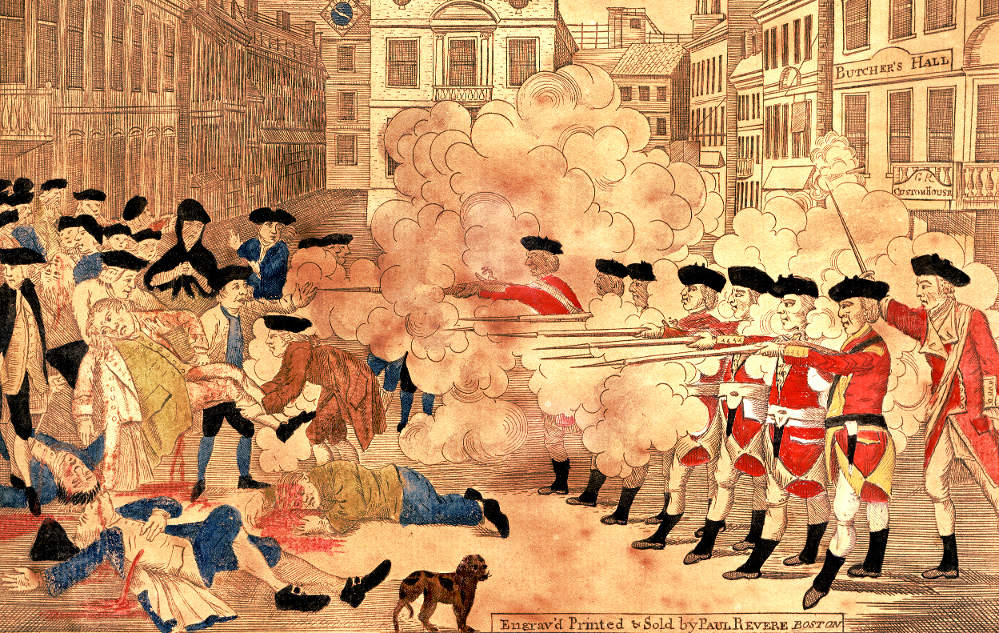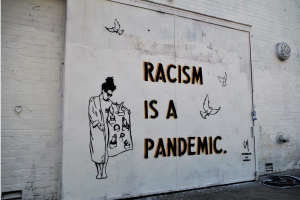On the day of March 5, 1770, roughly around 9:00 p.m. in Boston, Massachusetts, the tension between the Boston colonists and the British soldiers had reached its breaking point. Soldiers at this time were stationed in the colonies to protect and support the colony’s officials implementing the unpopular taxes on the colonists. Eight soldiers and one officer of the Twenty-ninth Regiment had been guarding the Custom-House on King Street when a mob of angry colonists, who were upset about the unfair taxes imposed on them by King George III, began to rally around them. The altercation had begun with the colonists verbally threatening the soldiers, but little by little things became worse. The colonist began to throw rocks and snowballs, and were even taking swings at the soldiers with clubs. Without being given the order to fire upon the colonists, the soldiers began to fire their muskets into the crowd of colonists, instantly killing three people in the mob and wounding eight others, two of whom were later pronounced dead. The five “victims transformed into the first martyrs of American independence,” wrote Hiller B. Zobel. The shooting became known as the Boston Massacre to all people in the colonies and as The Incident on King Street to the people of Great Britain.1
Patriots in Boston, such as Samuel Adams and Paul Revere (who painted the famous depiction of the soldiers firing on the crowd), were quick to have their local papers write about the shooting, labeling it a senseless act of violence on innocent by-standers. They believed this would help them get other Bostonians to hate the British soldiers occupying Boston. Shortly after the incident, by-standers were questioned on what had happened just moments ago, some of whom said they not only saw the soldiers on the streets firing on the people, but that they also saw fire coming from the second story of the Custom-House. The rumor was tested by a ballistics expert named Benjamin Andrews. He was able to track a bullet hole on a window from a business right across the street from the Custom-House, and he determined that the bullet came from “just under the stool of the westernmost lower chamber window of the Custom-House.”2 Local government noticed how much this incident riled up the people of Boston, and were committed to giving the soldiers and instigators a fair trial in court in order to prevent the British government as well as the Patriots from retaliating.
The soldiers had a hard time finding a lawyer to argue their case in court. Officer Preston, however, called for the future president and leading patriot John Adams to defend them. It was said that John Adams agreed to defend Officer Preston and the rest of the soldiers involved in the shooting in order to guarantee a fair trial for them. The town of Boston hired prosecutors Samuel Quincy and Robert Treat Paine to handle the cases of Officer Preston and the soldiers who were involved in the incident. Officer Preston and his soldiers were tried in separate trials.3

Seven months later, in October 1770, Officer Preston’s trial was held. After a lengthy trial, the jury in the case agreed that Officer Preston had not ordered his soldiers to open fire on the angry mob, and ultimately decided that he was not guilty of manslaughter, and he was acquitted from the crime. In the trial held for the soldiers, six of the eight were also found innocent and were acquitted; the two remaining soldiers were not so lucky. The last two soldiers were found guilty of manslaughter and were branded on the thumb as punishment, and then set free. Some people felt that the punishment did not fit the crime, but aside from the branding of the two soldiers, all soldiers involved in the Boston Massacre were withdrawn from the town and were “removed to the castle in the harbor” and were no longer there to enforce the unfair taxes on the people of Boston.4
- Hiller B. Zobel, “The Boston Massacre,” The William and Mary Quarterly, Vol. 27, No. 4, (1970): 675. ↵
- O. M. Dickerson, “The Commissioners of Customs and the ‘Boston Massacre,'” The New England Quarterly Vol. 27, No. 3, (1945): 317. ↵
- Louise Phelps Kellogg, “The Paul Revere Print of the Boston Massacre, “The Wisconsin Historical Magazine of History, Vol. 1, No. 4, (1918): 377-387. ↵
- Louise Phelps Kellogg, “The Paul Revere Print of the Boston Massacre, “The Wisconsin Historical Magazine of History, Vol. 1, No. 4, (1918): 378. ↵



39 comments
Lianna Ybarra
I really like how you started your article in the middle of the story. I think that’s what really makes your article. I really didn’t know much about the Boston Massacre until I had read this article. I think it’s funny and strange though how they threw snow balls at the soldiers. Overall, great article!
Mario Sosa
Interesting to hear how this event was interpreted differently, as the colonies called it a massacre while Great Britain called it an “incident”. I found it strange how the two soldiers held on trial got their thumbs branded. I would have figured that they would get the death sentence, or at least some jail time. This was a good read; wonderful job on the article!
Johnanthony Hernandez
Interesting article, few know the full story behind the Boston Massacre and the the events after the shooting. It still makes me think that the colonist antagonized the British and they responded with accidental firing. I can see that your article was well researched down to the trails that took place and that you have all the events in chronological order.
Sergio Cervantes
I liked the way you introduced the article by describing the circumstances of the event. I did not know John Adams was hired to be the defendants’ lawyer and successfully completed his task guaranteeing all of them their freedom. It is interesting to read how the colonists were actually the first ones to start the “dispute”; the British soldiers were merely doing their duties. Nonetheless, this event would change the American colonies forever ending with the birth of a new nation.
Erick Martinez
Very good article, you had a great flow to your writing that was very easy to follow. I found myself trying to understand why the British soldiers would choose to fire as a response to the snowballs and rocks, especially without being ordered to do so. I find this very odd and can just imagine how outraged the Boston colonists must have been. Overall this was a good article with plenty of information throughout, the amount of effort you put into research is obvious.
Bailey Rider
This is a good article! It was interesting to think about how taxes caused an event like this to happen and how the event blew up so fast. It’s also cool how this event was used as propaganda for the cause. You did a good job of highlighting all of the key points of the massacre and it was an interesting read. Thank you for the article!
Luke Trevino
I love how the article was short and to the point but with very important details. I had never known that the people where throwing rocks and hitting them with clubs. Yes this was violent extremely unnecessary but never enough to take life’s. The punishment did not fit the crime in anyway. Being branded on the thumb and asked to move was not a worthy crime for those soldiers. I believe prestons trial was fair and If he had not given the order to fire he should of been set free. Overall very good essay!
Lianna Ybarra
I enjoyed your article a lot! I found it very informative and interesting. To be honest, I had heard of the Boston Massacre but I thought it was something different from this. I think it is unfortunate that the tension between the soldiers and the residents had become that bad to where the residents started to attack the soldiers. Regardless though, the soldiers shouldn’t have opened fire at the residents.
Priscilla Reyes
Great article! You did awesome at telling the story and being informative. For example, I didn’t know of the trial that followed for both the soldiers, and the officer. (Interesting that they were trialed separately!) I also found it interesting that there are two names for this event and how the Bostonians managed to anger the soldiers, and this eventually led to them leaving the town. Lastly, good job on your use of images!
Zaraly Frasquillo
I really enjoyed reading your article it was not just a regular old research article, it was more like an amazing story, that deserves praise. I am not going to lie, I kind of giggled when I read that the Boston colonists threw snow balls at the British soldiers. I think you did an amazing job researching, and telling a great story!